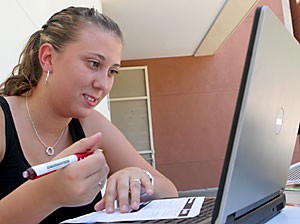Students with laptop computers will have the opportunity to enjoy more freedom in August when the first phase of a campus-wide wireless Internet system will be complete, administrators said.
“”The buildings are being wired as we speak,”” said Bob Lancaster, co-director of the Center for Computing and Information Technology.
The initial phase will provide wireless Internet access in the Student Union Memorial Center, Park Student Union, Main Library, Manuel T. Pacheco Integrated Learning Center and the Science and Engineering Library.
Wireless Internet will also be available on the UA Mall from Old Main to North Campbell Avenue, Lancaster said.
Throughout the summer, workers installed about 100 Internet access points a week, and they will continue to do so until “”phase zero”” of the project is completed in early August, Lancaster said.
Camille Jehle, a political science junior, said she likes the idea of having more areas on campus with wireless Internet access because it will free up space in the ILC for people who don’t have computers.
“”Come finals time, a lot of people will utilize the extra space,”” Jehle said. “”I spend a lot of time on campus, and I’d much rather study in places other than the ILC.””
The wireless expansion is funded by a $65-per-year student technology fee that was approved by the Arizona Board of Regents in March, which students will begin to pay in August.
The UA requested $6.5 million from the fee to fund the wireless expansion project, but the regents only approved $4.5 million for the project, Lancaster said.
“”We didn’t get fully funded, but we plan to use the money we have to get as much done as possible,”” Lancaster said.
The next step of the project is to bring wireless Internet into the classrooms, Lancaster said.
“”Students asked for classrooms to be a high priority, so we’ll target those spaces high on our priority list,”” Lancaster said.
CCIT administered a student survey in the spring to gauge where students want wireless Internet access. About 47 percent of the students surveyed said they want wireless access in the classroom, 19 percent want it in the common areas outside and 11 percent want wireless Internet in residence halls.
Although nearly half the students surveyed wanted wireless Internet in the classroom, some teachers find the idea of having unlimited Internet access a cause for concern.
“”I don’t want it; not in the classroom,”” said Susan Crane, a history professor. “”The temptation to Web surf would be too great. It would be a huge distraction. I would have to consider not allowing laptops in class.””
A timeline of when wireless Internet will be available in other departments and classrooms has yet to be determined, but organizers said a timeline will be in the works once “”phase zero”” is complete.
Details about how students can sign up for wireless Internet are not available at this time, but should be available before the fall semester begins, Lancaster said.
“”We need a couple of weeks to test, configure and play with the new system,”” Lancaster said.
But once the system is in place, student support will be available through the Office of Student Computing Resources, said Limell’ Lawson, assistant director of OSCR.
OSCR student employees will be trained to handle questions about the new wireless technology in order to help students with setup, troubleshooting and general wireless Internet support, Lawson said.









